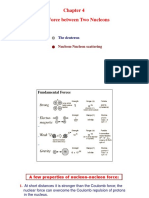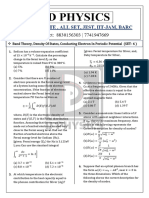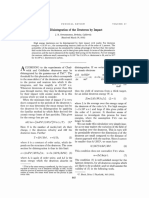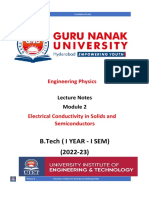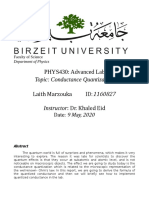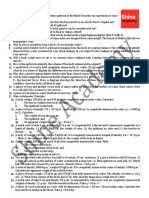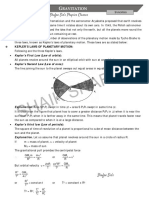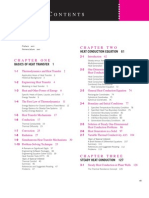Rohini 14147559957
Rohini 14147559957
Uploaded by
Midhun MCopyright:
Available Formats
Rohini 14147559957
Rohini 14147559957
Uploaded by
Midhun MOriginal Title
Copyright
Available Formats
Share this document
Did you find this document useful?
Is this content inappropriate?
Copyright:
Available Formats
Rohini 14147559957
Rohini 14147559957
Uploaded by
Midhun MCopyright:
Available Formats
ROHINI COLLEGE OF ENGINEERING AND TECHNOLOGY
UNIT V
NANOELECTRONIC DEVICES
5.1.INTRODUCTION
Nanoscience is a branch of science which deals with the study of phenomena and
manipulation of materials at nanometer scales.
Nanotechnology is the design, production, characterization and application of
structures, devices and systems by controlling shape and size at the nanometer scale.
Definition: Nanomaterials are newly developed materials with grain (particle) size
at the nanometer range (1nm = 10-9) ie., in the order of 1 – 100 nm.
Nano devices are the devices which consists of nano materials, its efficiency is
more.
Nano electronics refers to the use of nanotechnologyin electronic components,
especially transistors.
The unique micro structure provides tremendous strength, hardness, formability and
toughness. to this is has tremendous strength, hardness, toughness and high magnetic
& chemical properties.
(Ex: nano copper is 5 times more stronger than ordinary copper)
PH3254-PHYSICS FOR ELECTRONICS ENGINEERING
ROHINI COLLEGE OF ENGINEERING AND TECHNOLOGY
ELECTRON DENSITY IN BULK MATERIAL
Definition:Electron density is the number of electrons per unit volume in a material.
It is determined by using density of energy states.
In a solid, the total number of electron energy states ‘N’ with energies upto ‘E’ is
determined based on quantum mechanics using the following equation.
N
8𝜋 a3
=( ) (2mE)3⁄2 ( ) −−−−
3 h3
− (1)
Here, ‘𝑎3’ → Volume of the material (‘a’ is the characteristic dimension of the
solid)
E → Maximum energy level m → Mass of an electron h →
Planck‟s constant.
N
∴ Number of energy states per unit volume, n =
a3
8𝜋 (2mE)3⁄2
=( ) − − − − (2)
3 h3
Density of states function, D(E) is obtained after taking the derivative of this
expression with respect to energy (dn ).
dE
dn
Number of energy states per unit volume per unit energy, D(E) =
dE
d 8𝜋 (2mE)3⁄2
= * +
dE 3 h3
8𝜋 (2m)3⁄2 d(E)3⁄2
=
3 h3 dE
8𝜋 23⁄2m3⁄2 3 3 −1
= ( E2 )
3 h3 2
8𝜋 21 × 21⁄2m3⁄2 3 1⁄2
= × ( E )
3 h3 2
PH3254-PHYSICS FOR ELECTRONICS ENGINEERING
ROHINI COLLEGE OF ENGINEERING AND TECHNOLOGY
8 √2 m3⁄2
D(E) = × √E − − − − − (3)
h3
In a conductor at ‘0 K’, the electron distribution goes from zero energy upto Fermi
energy ‘EF’
So, the number of free electrons per unit volume or electron density in a bulk
conductor at „0 K‟
8𝜋 (2mEF)3⁄2
𝑛𝑒 = ( ) − − − − − (4)
3 h3
SIZE DEPENDENCE OF FERMI ENERGY
Fermi energy:
It is defined as the highest energy level occupied by the electron at „0K‟ in
metal
h2 3ne 2⁄3
Fermi energy, EF = ( )
2m 8𝜋
Here, ne is the only variable and all the other terms are constants.
So, we can write, EF ∞ ne
Thus, Fermi energy of the conductor just depends on the number of free electrons
per unit volume (electron density).
As the elctron density is a property of the material, Fermi energy does not vary with
the material‟s size.
EF is same for small volume and large volume materials. Also it is same for small
size and large size materials.
But, the average spacing between energy states is inversly proportional to the
volume of the solid.
1 1
∆E ∞ (or) ∆E ∞
V a3
PH3254-PHYSICS FOR ELECTRONICS ENGINEERING
ROHINI COLLEGE OF ENGINEERING AND TECHNOLOGY
QUANTUM CONFINEMENT
Definition: It is a process of reduction of the size of the solid such that the
energy levels inside becomes discrete.
In this case, small “droplets” of isolated electrons are created.
Hence, it is possible for us to count few electrons.
This effect is observed when the size of the particle is too small.
If we decrease the size of the particle to nano size, the decrease in
confining size creates the energy levels discrete.
The formation of discrete energy levels increases or widens up the band
gap and finally the band gap energy also increases
Since, the band gap and wavelength are inversely related to each other the
wavelength decreases with decrease in size and the proof is the emission
of blue radiation.
QUANTUM STRUCTURES
A quantum confined structure is one in which the motion of the electrons or holes
are confined in one or more directions by potential barriers.
Based on the confinement direction, quantum confined structure will be classified
into three categories as quantum well, quantum wire and quantum dot.
PH3254-PHYSICS FOR ELECTRONICS ENGINEERING
ROHINI COLLEGE OF ENGINEERING AND TECHNOLOGY
Types of structure
1. Quantum well(2D): When the electrons are confined in onedimension
then the structure is known as quantum well
2. Quantum wire(1D): When two dimensions are minimized, then the structure is
known as quantum wire.
3. Quantum dots(0D): When three dimension are minimized then itis quantum wire
The classification is shown below in table.
Quantum Number of
Structure
Confinement dimensions
Bulk 0 3 (x, y, z)
Quantum well 1 (z) 2 (x, y)
Quantum wire 2 (x, y) 1 (z)
Quantum dot 3 (x, y, z) 0
DENSITY OF STATES IN QUANTUM WELL
The two dimensional density of states is the number of states per unit area and
unit energy.
Let us consider an electron in a two dimensional potential well. The electron is
confined in the well.
We have to find out number of energy levels available in between E and E+dE
The space consists of only X-Y plane
In 2 dimensional space 𝑛2 = 𝑛2 + 𝑛2
𝑥 𝑦
𝑁𝑜. 𝑜ƒ 𝑒𝑛𝑒𝑟𝑔𝑦 𝑠𝑡𝑎𝑡𝑒𝑠 𝑤i𝑡ℎi𝑛 𝑡ℎ𝑒 𝑐i𝑟𝑐𝑙𝑒 𝑜ƒ 𝑟𝑎𝑑i𝑢𝑠 ‘𝑛’
= 𝜋𝑛2 − − − − − − (1)
PH3254-PHYSICS FOR ELECTRONICS ENGINEERING
ROHINI COLLEGE OF ENGINEERING AND TECHNOLOGY
𝑁𝑜. 𝑜ƒ 𝑒𝑛𝑒𝑟𝑔𝑦 𝑠𝑡𝑎𝑡𝑒𝑠 𝑤i𝑡ℎi𝑛 𝑡ℎ𝑒 𝑐i𝑟𝑐𝑙𝑒 𝑜ƒ 𝑟𝑎𝑑i𝑢𝑠 ‘𝑛 + 𝑑𝑛’
= (𝑛 + 𝑑𝑛)2 − − − − (2)
The quantum numbers (nx and ny) can have only positive integer values. It will
have positive values
𝑡ℎ
at 1 part of the circle.
4
1
No. of energy states within the circle of radius ‘𝑛’ = × 𝜋𝑛2
4
1
= 𝜋𝑛2 − − − − (3)
4
1
No. of energy states within the circle of radius ‘𝑛 + 𝑑𝑛’ = × (𝑛 + 𝑑𝑛)2
4
1
= (𝑛 + 𝑑𝑛)2 − − − − (4)
4
No. of energy states between energy interval E and E + dE
1 1
𝜋 (𝑛 + 𝑑𝑛)2 − 𝜋𝑛2
(𝐸) 𝑑𝐸 =
4 4
1
(𝐸) 𝑑𝐸 = 𝜋 [(𝑛 + 𝑑𝑛)2 − 𝑛2]
4
1
(𝐸)𝑑𝐸 = 𝜋 (𝑛2 + 2𝑛𝑑𝑛 + 𝑑𝑛2 - 𝑛2) − − − (5)
4
Since „dn‟ is very small the higher orders of „dn‟ can be neglected.
𝜋
𝑍(𝐸) 𝑑𝐸 = × 2ndn
4
𝜋
𝑍(𝐸)𝑑𝐸 = 𝑛 𝑑𝑛 − − − − (6)
2
The energy of an electron in a cubical metal piece of sides ‘𝑎’ is given by, 𝐸
𝑛2ℎ2
= − − − − − − − − − − − − − − − (7)
8𝑚𝑎2
𝑛2ℎ2 = 8𝑚𝑎2𝐸
8𝑚𝑎2𝐸
𝑛2 = − − − − (8)
ℎ2
1
8𝑚𝐸 2
𝑛=[ 2 ] 𝑎 − − − − (9)
ℎ
PH3254-PHYSICS FOR ELECTRONICS ENGINEERING
ROHINI COLLEGE OF ENGINEERING AND TECHNOLOGY
ifferentiating equation (9)with respect to ‘n’ we get,
1
8𝑚 2 1 1
−1
𝑑𝑛 = [ 2 ] 𝑎 𝐸 2 𝑑𝐸 − − − − − (10)
ℎ 2
1
1 8𝑚 2 1
−
dn = [ 2 ] 𝑎 𝐸 2 𝑑𝐸 − − − − (11)
2 ℎ
Substituting (9)& (11) in (6)we get,
1 1
𝜋 8𝑚𝐸 2 1 8𝑚 2 −
1
Z(E)dE = [ ] 𝑎 [ 2 ] 𝑎 𝐸 2 𝑑𝐸 − − − − (12)
2 ℎ2 2 ℎ
𝜋 8𝑚
Z(E)dE = ( ) 𝑎2𝐸0𝑑𝐸 − − − (13)
4 ℎ 2
Pauli‟s exclusion principle states that “Two electrons of opposite spin can occupy each
state”. Hence, the number of energy states available for electron occupancy is given by,
𝜋 8𝑚
Z(E)dE = 2 × ( ) 𝑎2𝐸0𝑑𝐸 − − − − (14)
4 ℎ 2
𝜋 8𝑚
Z(E)dE = ( ) 𝑎2𝐸0𝑑𝐸 − − − − (15)
2 ℎ 2
The number of energy states per unit area per unit energy is
𝜋 8𝑚
Z(E) = ( ) 𝐸0 (∴ 𝑎2 = 1 ƒ𝑜𝑟 𝑢𝑛i𝑡 𝑎𝑟𝑒𝑎 )
2 ℎ2
Z(E) 𝖺 𝐸0
i. e Z(E)2D 𝖺 𝐸0 = constant
This is the expression for density of charge carriers in the energy interval E and E+dE
in a quantum well
PH3254-PHYSICS FOR ELECTRONICS ENGINEERING
ROHINI COLLEGE OF ENGINEERING AND TECHNOLOGY
DENSITY OF STATES IN QUANTUM WIRE
The one dimensional density of states is the number of states per unit length and unit
energy.
Let us consider an electron in a one dimensional quantum wire. We have to find out
number of energy
levels available in between E and E+dE
The space consists of only X plane
In 1 dimensional space 𝑛2 = 𝑛2𝑥
𝑁𝑜. 𝑜ƒ 𝑒𝑛𝑒𝑟𝑔𝑦 𝑠𝑡𝑎𝑡𝑒𝑠 i𝑛 𝑡ℎ𝑒 𝑤i𝑟𝑒 𝑜ƒ 𝑙𝑒𝑛𝑔𝑡ℎ ‘𝑛’ = 𝑛 − − − − − − (1)
𝑁𝑜. 𝑜ƒ 𝑒𝑛𝑒𝑟𝑔𝑦 𝑠𝑡𝑎𝑡𝑒𝑠 i𝑛 𝑡ℎ𝑒 𝑤i𝑟𝑒 𝑜ƒ 𝑙𝑒𝑛𝑔𝑡ℎ ‘𝑛 + 𝑑𝑛’
= 𝑛 + 𝑑𝑛 − − − − (2)
The quantum numbers (nx) can have only positive integer values. It will have
𝑡ℎ
positive values at 1 part
2
of the wire.
1
No. of energy states within the wire of length ‘𝑛’ = × 𝑛
2
1
= 𝑛 − − − − (3)
2
1
No. of energy states within the wire of length ‘𝑛 + 𝑑𝑛’ = × (𝑛 + 𝑑𝑛)
2
1
= (𝑛 + ) − − − − (4)
2
No. of energy states between energy interval E and E + dE
1 1
𝑍(𝐸) 𝑑𝐸 = (𝑛 + ) − 𝑛
2 2
1
(𝐸) 𝑑𝐸 = [𝑛 + 𝑑𝑛 − 𝑛]
2
1
𝑍(𝐸)𝑑𝐸 = (𝑑𝑛) − − − (5)
2
PH3254-PHYSICS FOR ELECTRONICS ENGINEERING
ROHINI COLLEGE OF ENGINEERING AND TECHNOLOGY
The energy of an electron in a cubical metal piece of sides ‘𝑎’ is given by, 𝐸
𝑛2ℎ2
= − − − − − (6)
8𝑚𝑎2
𝑛2ℎ2 = 8𝑚𝑎2𝐸
8𝑚𝑎2𝐸
𝑛2 = − − − − (7)
ℎ2
1
8𝑚𝐸 2
𝑛=[ 2 ] 𝑎 − − − − (8)
ℎ
Differentiating equation (11)with respect to ‘n’ we get,
1
8𝑚 2 1 1
−1
𝑑𝑛 = [ 2 ] 𝑎 𝐸2 𝑑𝐸 − − − − − (9)
ℎ 2
1
1 8𝑚 2 1
−
dn = [ 2 ] 𝑎 𝐸 2 𝑑𝐸 − − − − (10)
2 ℎ
Substituting (10) in (5)we get,
1
1 1 8𝑚 2 1
Z(E)dE = [ 𝑎 𝐸 −2
𝑑𝐸 − − − − (11)
2 2 ℎ2 ]
1
1 8𝑚 2 1
Z(E)dE = [ 2 ] 𝑎 𝐸 −2𝑑𝐸 − − − (12)
4 ℎ
Pauli‟s exclusion principle states that “Two electrons of opposite spin can occupy each
state”.
Hence, the number of energy states available for electron occupancy is given by,
1
1 8𝑚 2 −
1
Z(E)dE = 2 × [ 2 ] 𝑎 𝐸 2𝑑𝐸 − − − − (13)
4 ℎ
1
1 8𝑚 2 −
1
Z(E)dE = [ 2 ] 𝑎 𝐸 2𝑑𝐸 − − − − (14)
2 ℎ
The number of energy states per unit length per unit energy is
1
1 82 1
Z(E) = [ 2 ] −2 (∴ 𝑎 = 1 ƒ𝑜𝑟 𝑢𝑛i𝑡 𝑙𝑒𝑛𝑔𝑡ℎ )
2 ℎ
1
Z(E) 𝖺 𝐸−2
PH3254-PHYSICS FOR ELECTRONICS ENGINEERING
ROHINI COLLEGE OF ENGINEERING AND TECHNOLOGY
1
i. e Z(E)1D 𝖺 𝐸−2
This is the expression for density of charge carriers in the energy interval E and E+dE
in a quantum wire.
DENSITY OF STATES IN QUANTUM DOT
In quantum dot, the electron is confined in all three dimensions and hence no
motion of electron is possible. So the density of states is merely a delta function.
Z(E)1D = 2𝛿
2 accounts for spin
Type of structures & No. of non
Density of state function
confinement diemensions
8𝜋 √2 m*3⁄2(E − Ec)1⁄2
Bulk (3D) D(E) =
h3
4𝜋m*
Quantum well (2D) D(E) = E > Ei, i = 1, 2, 3
h2
2 √2 m* (E − Ei)−1⁄2
D(E) = ; i
Quantum wire (1D) h
= 1,2,3
D(E) = 𝛿 (E − Ei) ; i
Quantum dot (0D)
= 1,2,3
PH3254-PHYSICS FOR ELECTRONICS ENGINEERING
You might also like
- CHM131 - Chapter 2 - Structure of Atom - PeriodicityDocument97 pagesCHM131 - Chapter 2 - Structure of Atom - PeriodicityLeo PietroNo ratings yet
- Lecture Notes Solid State Physics 1Document28 pagesLecture Notes Solid State Physics 1SOURAV KUMAR PATELNo ratings yet
- Edc JaganDocument196 pagesEdc JagansrinivasNo ratings yet
- Emd U5Document54 pagesEmd U5vpurushothaman46No ratings yet
- Tute 1 ModifiedDocument3 pagesTute 1 ModifiedyoutuberNo ratings yet
- Lecture 3: Electron Statistics in A SolidDocument11 pagesLecture 3: Electron Statistics in A SolidHiếu LêNo ratings yet
- Solid State Physics: Module 1 Part-Ii Lecture 4 PH101 AUTUMN 2020Document35 pagesSolid State Physics: Module 1 Part-Ii Lecture 4 PH101 AUTUMN 2020Rohith RohanNo ratings yet
- Lecture Notes Solid State Physics 2Document15 pagesLecture Notes Solid State Physics 2SOURAV KUMAR PATELNo ratings yet
- Waves in Media: Ashcroft and Mermin, Solid State Physics (Saunders College, 1976, Page 553)Document42 pagesWaves in Media: Ashcroft and Mermin, Solid State Physics (Saunders College, 1976, Page 553)Amina lbrahimNo ratings yet
- Homework 2Document2 pagesHomework 2ombraga1896No ratings yet
- Review Article ReportDocument7 pagesReview Article ReportTanu ChoudharyNo ratings yet
- DR TMMP (Quantum)Document50 pagesDR TMMP (Quantum)Tmmp SmileNo ratings yet
- محاضره ثانيهDocument14 pagesمحاضره ثانيهsajadjudo871No ratings yet
- PSD Lectures - All FilesDocument198 pagesPSD Lectures - All FilesAnonymous UjlcFXP661No ratings yet
- 2012 Ee358 EmagII MidTerm IDocument2 pages2012 Ee358 EmagII MidTerm IYavuz KaplanNo ratings yet
- DielectricsDocument16 pagesDielectrics23wh1a05h5No ratings yet
- Free Electron Fermi Gas (FEFG) : Phys 175A Dr. Ray Kwok SjsuDocument38 pagesFree Electron Fermi Gas (FEFG) : Phys 175A Dr. Ray Kwok SjsuGetachew YirgaNo ratings yet
- Physical and Biological Aspects of Nanoscience and NanotechnologyDocument44 pagesPhysical and Biological Aspects of Nanoscience and NanotechnologyEstudiante2346No ratings yet
- Electromagnetic Fields (ECEG-2122) : Electric Fields in Material BodyDocument33 pagesElectromagnetic Fields (ECEG-2122) : Electric Fields in Material BodyjemalNo ratings yet
- 38 NovikovDocument3 pages38 Novikov何大仁No ratings yet
- The Model of Kronig and PenneyDocument6 pagesThe Model of Kronig and PenneyAdya PradiptaNo ratings yet
- 5-Introduction To Optics, Photonics and optoelectronics-10-Jul-2019Material - III - 10-Jul-2019 - 02 - SemiconductorsI - IntrinsicDocument34 pages5-Introduction To Optics, Photonics and optoelectronics-10-Jul-2019Material - III - 10-Jul-2019 - 02 - SemiconductorsI - IntrinsicIyyaasuu YaadataaNo ratings yet
- CH1018E-Ch1. - U1-The Structure of Atoms-Lectuer NotesDocument55 pagesCH1018E-Ch1. - U1-The Structure of Atoms-Lectuer NotesHà ChiNo ratings yet
- Simulation and Analysis of III V Characteristic and Bandgap Design For Heterojunction Laser DiodeDocument5 pagesSimulation and Analysis of III V Characteristic and Bandgap Design For Heterojunction Laser DiodeEditor IJTSRDNo ratings yet
- 5.3.2 Isotype Junctions, Modulation Doping, and Quantum EffectsDocument4 pages5.3.2 Isotype Junctions, Modulation Doping, and Quantum EffectsprashantsheetalNo ratings yet
- The Force Between Two NucleonsDocument68 pagesThe Force Between Two NucleonsNeha MageshwarNo ratings yet
- RomJPhys 64 113Document20 pagesRomJPhys 64 113Cayuss Andrei MihăițoaiaNo ratings yet
- Band Theory,Density,Conducting Electron In Periodic Potential SET- 06Document4 pagesBand Theory,Density,Conducting Electron In Periodic Potential SET- 06suvadippatra625No ratings yet
- Oppenheimer, Robert The Disintegration of The Deuteron by ImpactDocument2 pagesOppenheimer, Robert The Disintegration of The Deuteron by ImpactDark SwordNo ratings yet
- Self-Study "Haynes - Shockley Experiment" Assignment 2022: C S E SDocument5 pagesSelf-Study "Haynes - Shockley Experiment" Assignment 2022: C S E SThulasizwe PhethaNo ratings yet
- Ip-Map 19960595Document5 pagesIp-Map 19960595kurtayNo ratings yet
- Mackay 2008Document89 pagesMackay 2008muna mohammedNo ratings yet
- Progress in Electromagnetics Research, Vol. 132, 149-158, 2012Document10 pagesProgress in Electromagnetics Research, Vol. 132, 149-158, 2012程宇凡No ratings yet
- Electrical Properties of Materials and Applications: Applied Physics For CSE StreamDocument17 pagesElectrical Properties of Materials and Applications: Applied Physics For CSE Streamchandan rs22No ratings yet
- Module 2 - Lecture Notes - Engineering PhysicsDocument40 pagesModule 2 - Lecture Notes - Engineering PhysicsDamodhar reddy GarlapatiNo ratings yet
- Lecture 2 Electronic Structure of AtomsDocument72 pagesLecture 2 Electronic Structure of AtomsKEMPNo ratings yet
- ELK364E Lecture 1 ConductivityDocument64 pagesELK364E Lecture 1 ConductivitySemih YILDIRIMNo ratings yet
- 101 Chapter (7) Electronic Structure ChangDocument30 pages101 Chapter (7) Electronic Structure ChangWadeea YounisNo ratings yet
- Chapter12 2Document20 pagesChapter12 2Yus NordinNo ratings yet
- Unit 5Document47 pagesUnit 5Abhinav AlokNo ratings yet
- General Instructions:: Sample Question Paper - 23 Physics (042) Class-XII, Session: 2021-22Document6 pagesGeneral Instructions:: Sample Question Paper - 23 Physics (042) Class-XII, Session: 2021-22abcdNo ratings yet
- CH 7Document60 pagesCH 7Paul ArcillaNo ratings yet
- Chapter 3Document106 pagesChapter 3AnthonyNo ratings yet
- Atomic Physics3Document13 pagesAtomic Physics3Rashid AliNo ratings yet
- Verifying The Drude Response: Martin DresselDocument10 pagesVerifying The Drude Response: Martin Dresselgregoryaa9No ratings yet
- Note 3 CDocument9 pagesNote 3 Cpalmer okiemuteNo ratings yet
- ENEE 313, Fall. '08 Homework II - Due March 30, 2009: N D E DKDocument2 pagesENEE 313, Fall. '08 Homework II - Due March 30, 2009: N D E DKSidi AmadouNo ratings yet
- DielectricsDocument61 pagesDielectricsKanda VelanNo ratings yet
- Sheet (1) (Revision On Semiconductor Fundamentals)Document4 pagesSheet (1) (Revision On Semiconductor Fundamentals)Abdelaziz MohamedNo ratings yet
- BlankDocument5 pagesBlankrz_taNo ratings yet
- Chapter 2 - Structure of Atom PeridiocityDocument97 pagesChapter 2 - Structure of Atom PeridiocityAina AthirahNo ratings yet
- 1.5 Invariance of The Fermi Level at EquilibriumDocument2 pages1.5 Invariance of The Fermi Level at EquilibriumSuman Kumar Mitra100% (1)
- 4R6Lab3 Dead Time 2017Document6 pages4R6Lab3 Dead Time 2017tarek mahmoudNo ratings yet
- 3.091 - Introduction To Solid State Chemistry Lecture Notes No. 1 Atomic and Electronic StructureDocument21 pages3.091 - Introduction To Solid State Chemistry Lecture Notes No. 1 Atomic and Electronic StructuresakibNo ratings yet
- ch7Document43 pagesch7Shella TanNo ratings yet
- PHYS430: Advanced Lab Laith Marzouka ID: Dr. Khaled Eid: Topic: Conductance QuantizationDocument8 pagesPHYS430: Advanced Lab Laith Marzouka ID: Dr. Khaled Eid: Topic: Conductance QuantizationLaith MarzoukaNo ratings yet
- Systematic Errors in The ACME Electron EDM Experiment: e e e eDocument9 pagesSystematic Errors in The ACME Electron EDM Experiment: e e e eDaniel Gordon AngNo ratings yet
- Feynman Lectures Simplified 2C: Electromagnetism: in Relativity & in Dense MatterFrom EverandFeynman Lectures Simplified 2C: Electromagnetism: in Relativity & in Dense MatterNo ratings yet
- Electron Beam-Specimen Interactions and Simulation Methods in MicroscopyFrom EverandElectron Beam-Specimen Interactions and Simulation Methods in MicroscopyNo ratings yet
- Third Dimension Induction BrochureDocument11 pagesThird Dimension Induction BrochureMidhun MNo ratings yet
- DebateDocument13 pagesDebateMidhun MNo ratings yet
- Partial Differentiation and Its ApplicationsDocument26 pagesPartial Differentiation and Its ApplicationsMidhun MNo ratings yet
- Problem Sheet Unit 2Document5 pagesProblem Sheet Unit 2Midhun MNo ratings yet
- Problem Sheet Unit 3Document4 pagesProblem Sheet Unit 3Midhun MNo ratings yet
- Problem Sheet Unit 4Document2 pagesProblem Sheet Unit 4Midhun MNo ratings yet
- Lab Report (Exp 1)Document11 pagesLab Report (Exp 1)NorfaizahNo ratings yet
- CBSE Class 11 Physics Notes - Surface Tension - AglaSem SchoolsDocument7 pagesCBSE Class 11 Physics Notes - Surface Tension - AglaSem SchoolsSanjeev dahiyaNo ratings yet
- 9TH - Icse - Physics - Preboard WorksheetDocument5 pages9TH - Icse - Physics - Preboard WorksheetmanojboaNo ratings yet
- JEE Main 2019 Physics January Attempt Shift - 1 (09th January, 2019)Document18 pagesJEE Main 2019 Physics January Attempt Shift - 1 (09th January, 2019)Resonance Eduventures96% (26)
- ElectroscopeDocument15 pagesElectroscopeVaijal Patel85% (13)
- Anomalous bulk-edgeDocument10 pagesAnomalous bulk-edgeripplesmusiccentreNo ratings yet
- Math 115 Lab 6 SolutionsDocument3 pagesMath 115 Lab 6 SolutionsDPNo ratings yet
- HW #12 - Radiation Heat Transfer-SolutionsDocument11 pagesHW #12 - Radiation Heat Transfer-SolutionsJason RodriguezNo ratings yet
- MODULE 1A - Physics 2: General Physics 2 Grade Level/Section: Subject TeacherDocument6 pagesMODULE 1A - Physics 2: General Physics 2 Grade Level/Section: Subject TeacherNicoleNo ratings yet
- Paper On ParafermionsDocument22 pagesPaper On ParafermionsKishore IyerNo ratings yet
- 364 - CE8402 Strength of Materials II (SOM 2) - Question BankDocument19 pages364 - CE8402 Strength of Materials II (SOM 2) - Question BankPRASANTHNo ratings yet
- Physics Velosity Time Graph - JPGDocument3 pagesPhysics Velosity Time Graph - JPGDanielle WilliamsonNo ratings yet
- Quantum Dots in Solar Cells: Hugh HiginbothamDocument17 pagesQuantum Dots in Solar Cells: Hugh HiginbothamRayes SwathNo ratings yet
- PVDF BandstructureDocument9 pagesPVDF BandstructureManjeet BhatiaNo ratings yet
- GRAVITATION-Shafee Sir.Document20 pagesGRAVITATION-Shafee Sir.jimmyemandeeNo ratings yet
- Heat Transfer - A Practical Approach - Yunus A. CengelDocument873 pagesHeat Transfer - A Practical Approach - Yunus A. Cengelvinodkonatham70378% (9)
- Som Unit 5Document30 pagesSom Unit 5Robinson PrabuNo ratings yet
- GST105 Module2Document60 pagesGST105 Module2cydgreatofafricaNo ratings yet
- 11625Document17 pages11625Manish Kumar SinghNo ratings yet
- Aryan - Resume For BTPDocument2 pagesAryan - Resume For BTPAryan IIITDNo ratings yet
- NBA Part II Mechanical Engineering (Criteria 1-7)Document382 pagesNBA Part II Mechanical Engineering (Criteria 1-7)hcmadhuNo ratings yet
- Advanced Analysis of Steel FramesDocument15 pagesAdvanced Analysis of Steel FramesKulal SwapnilNo ratings yet
- Model Paper Unit 1Document16 pagesModel Paper Unit 1Anne Nirmani RodrigoNo ratings yet
- Upang Cea Common Bes025 p1Document74 pagesUpang Cea Common Bes025 p1vincentfeliciano50No ratings yet
- Design Calculations For Electrical DesignDocument33 pagesDesign Calculations For Electrical DesignRamkumar Haridoss100% (1)
- The Effects of EM Radiations On Living Things and EnvironmentDocument15 pagesThe Effects of EM Radiations On Living Things and EnvironmentMelerose Dela SernaNo ratings yet
- Chap02 - Section2.1 2.2Document44 pagesChap02 - Section2.1 2.2amaniz32xxNo ratings yet
- Experiment 3 (No Load Blocked Rotor Test On Single Phase Im)Document5 pagesExperiment 3 (No Load Blocked Rotor Test On Single Phase Im)Adarsh SinghNo ratings yet
- Pile Footing Detailed Design CalculationDocument3 pagesPile Footing Detailed Design CalculationChris LeeNo ratings yet
- I JC Finite TimeDocument12 pagesI JC Finite TimeSanjiv CrNo ratings yet

























